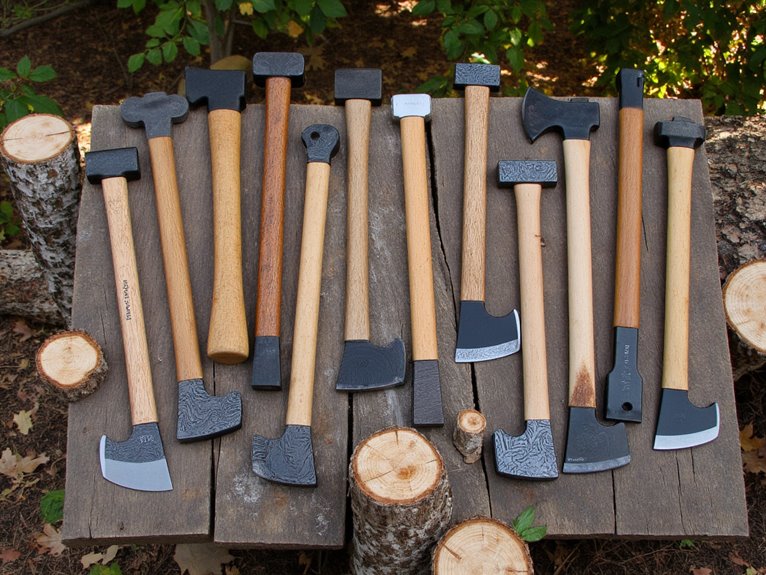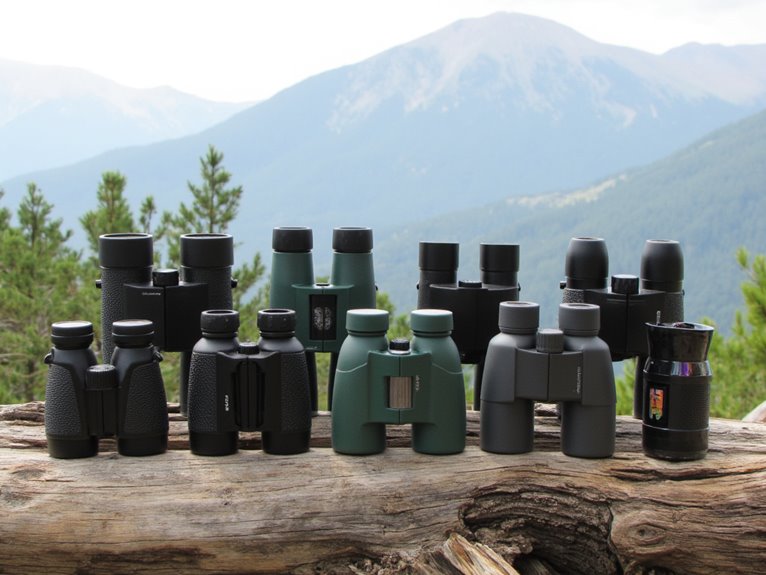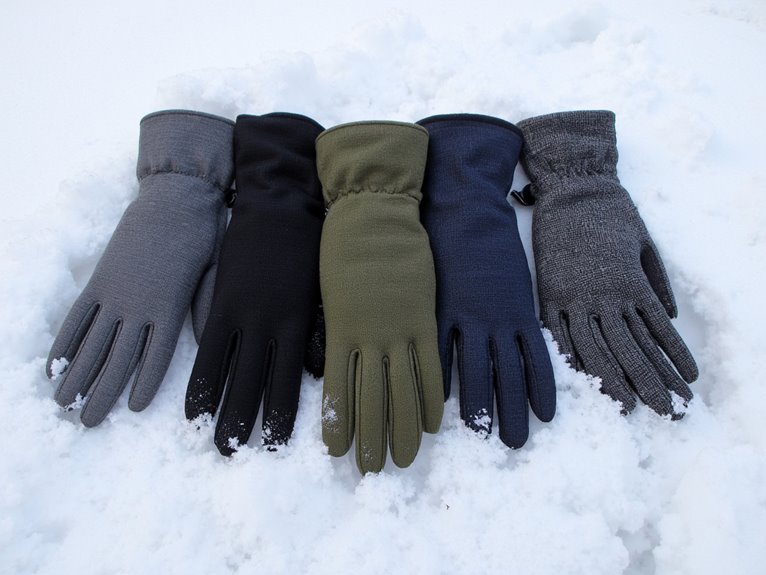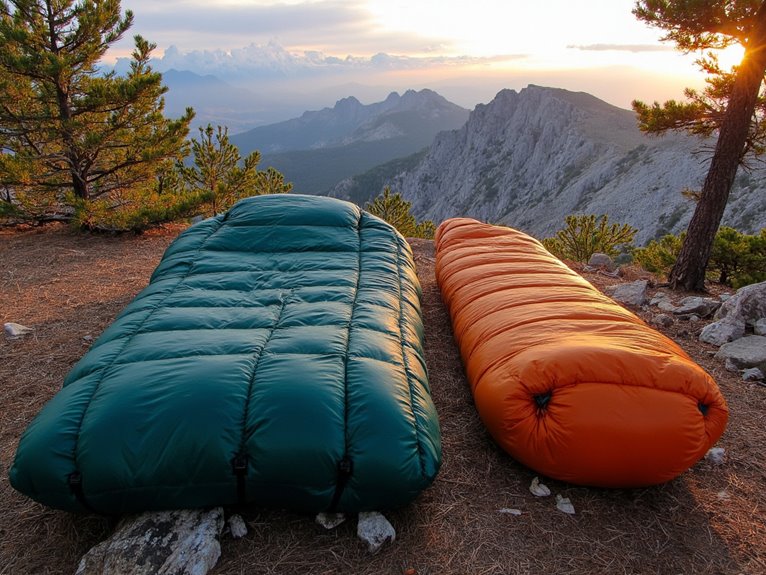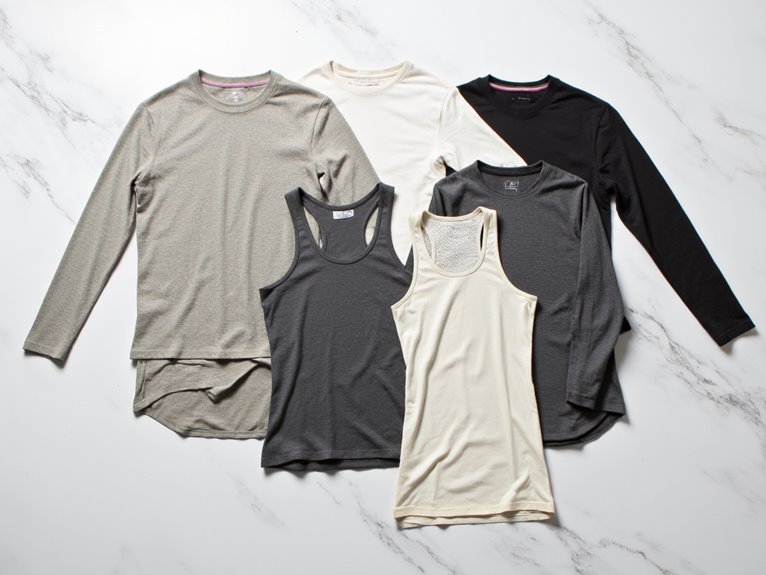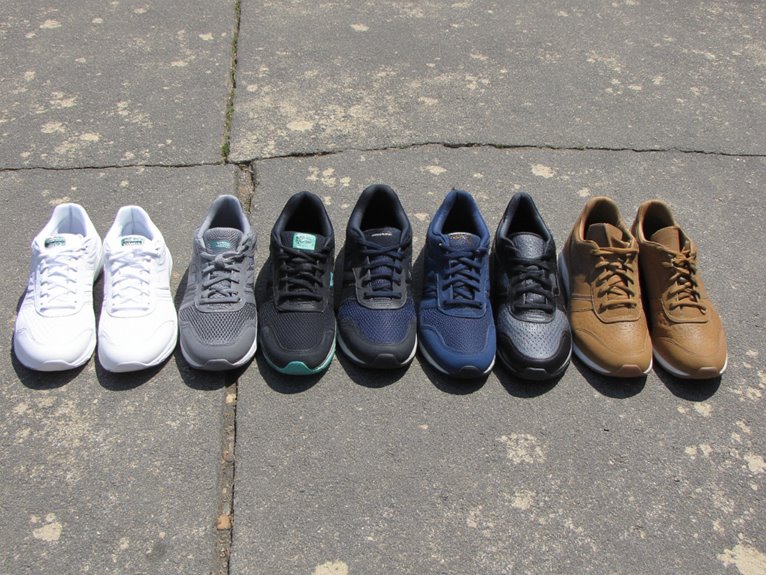How to Choose Waterproof Hiking Boots for Stream Crossings
You’ll need waterproof hiking boots with Gore-Tex or eVent membranes for reliable water barrier protection during stream crossings. Choose full-grain leather construction over synthetic materials for superior water resistance, and guarantee aggressive sole patterns with minimum 5mm lug depth for grip on wet rocks. Look for seam-sealed construction and gusseted tongues to prevent water infiltration at vulnerable points. Proper fit accommodating thicker socks prevents heel slippage in wet conditions. Understanding additional protective gear and maintenance techniques will maximize your boot’s performance in aquatic environments.
We are supported by our audience. When you purchase through links on our site, we may earn an affiliate commission, at no extra cost for you. Learn more. Last update on 7th January 2026 / Images from Amazon Product Advertising API.
Notable Insights
- Choose boots with Gore-Tex® or eVent® membranes and full-grain leather for maximum water resistance and breathability.
- Ensure aggressive sole patterns with 5mm+ lug depth and close spacing for superior traction on wet, slippery surfaces.
- Select boots with gusseted tongues and seam-sealed construction to prevent water infiltration at vulnerable stitching points.
- Verify proper fit that accommodates thicker socks while maintaining heel lockdown to prevent slippage and water entry.
- Consider pairing boots with mid-calf gaiters for additional protection against water entry from above during crossings.
Understanding Boot Materials and Construction for Water Resistance
How does a hiking boot actually keep water out while letting your feet breathe? The answer lies in waterproof membranes like Gore-Tex® and eVent® integrated into the boot’s upper construction.
These membranes use microscopic pores that block water droplets while allowing vapor molecules to escape, maintaining essential boot breathability.
Full-grain leather offers the highest water resistance due to its dense fiber structure. However, membrane durability depends heavily on sealed seams at stitching points.
Nubuck leather provides moderate protection with better flexibility, while synthetic materials rely entirely on membrane technology for waterproofing. Synthetic materials also offer the advantage of fast drying properties when compared to leather options.
Construction features enhance protection further. Gusseted tongues prevent water entry through lacing areas. High-cut designs with padded collars create barriers during stream crossings, while seam sealing technology covers vulnerable stitching holes throughout the boot. Quality stitching construction significantly impacts the boot’s overall durability and long-term waterproof performance in demanding conditions.
Evaluating Gaiters and Sock Systems for Stream Protection
Even the best waterproof boots can’t protect your feet when water enters from above during stream crossings or deep snow encounters. Gaiters and waterproof socks provide essential supplementary protection beyond your boots’ capabilities.
Different gaiter types offer varying protection levels. Waterproof gaiters create complete water barriers, while water-resistant models provide limited moisture blocking. Mid-calf to knee-high gaiters prevent water from climbing over boot tops during crossings.
Mid-calf to knee-high gaiters provide superior water protection by preventing stream water from climbing over boot tops during crossings.
Secure under-boot straps and adjustable closures maintain seal integrity without restricting movement.
Waterproof socks excel during brief submersions but lose effectiveness in prolonged exposure. Quality brands have improved sock breathability, reducing the common overheating issue.
For ideal stream protection, combine both systems: gaiters block splash and debris while waterproof socks handle foot-level immersion scenarios. Consider pairing your footwear protection with hiking pants that feature DWR coatings to extend water resistance throughout your lower body gear system.
Essential Boot Features for Safe Water Crossings
When crossing streams and steering through wet terrain, your boots must deliver three critical performance characteristics to guarantee both safety and comfort.
The outsole’s traction system becomes your primary defense against slipping on wet rocks, while the waterproofing construction determines whether you’ll maintain dry feet or deal with soggy boots for miles.
Your boot’s fit and security systems work as the final barrier, preventing water infiltration through loose collars and assuring stable footing when you need it most.
Boots with dual-material soles that combine rubber for traction with harder compounds provide superior grip on varied terrain conditions encountered during water crossings.
Traction and Sole Design
Traction serves as your lifeline when traversing treacherous water crossings, where a single misstep can transform an enjoyable hike into a dangerous ordeal. Your boot’s sole design determines whether you’ll maintain secure footing on slick rocks and unstable stream beds.
Effective lug material selection requires understanding rubber compounds. Vibram soles deliver superior durability and grip. Softer compounds enhance wet rock traction but wear faster than harder alternatives.
Critical sole pattern analysis factors:
- Lug depth – 5mm minimum penetrates loose surfaces and provides stream bed stability.
- Aggressive patterns – Shed mud efficiently while maintaining consistent grip throughout hikes.
- Close spacing – Prevents stone lodging in wet environments.
- Directional design – Facilitates uphill/downhill traction on wet surfaces with specialized siping.
Your midsole cushioning absorbs river stone impacts while flexible designs improve balance on uneven terrain. Multi-directional lugs are crucial for maintaining stability across varied surfaces you’ll encounter during stream crossings and the diverse terrain that follows.
Waterproofing and Material Construction
While superior traction keeps you stable on wet surfaces, your boot’s waterproof construction determines whether you’ll complete stream crossings with dry feet or spend miles sloshing in waterlogged footwear.
Upper durability starts with material selection. Full-grain leather provides robust water resistance and protection but weighs more and dries slowly. Synthetic materials like nylon reduce weight and accelerate drying but offer less inherent water resistance.
Many manufacturers combine both materials with sealed seams and gusseted tongues to prevent water entry through lacing areas.
Waterproof technologies center on breathable membranes like Gore-Tex, which block water ingress while allowing moisture vapor escape. However, these membranes trap water if it enters over the boot top.
The sole-to-upper bond requires full sealing, often reinforced with rubber rands wrapping the base for enhanced waterproof integrity. Quality waterproof systems maintain effectiveness by integrating sealed seams with breathable panels, requiring regular maintenance to extend their protective capabilities.
Fit and Security Systems
Essential fit adjustments include accommodating thicker socks and orthotics commonly used in wet conditions.
Your boot’s heel lockdown system prevents lift during stream navigation, while proper arch support enhances balance on slippery surfaces.
Critical boot retention features include:
- Speed lacing systems with hooks or cam locks for quick changes and secure ankle stability
- Gusseted tongues that seal lace areas against water infiltration
- Dual-zone lacing allowing customized tightness at ankle versus forefoot
- Reinforced heel counters maintaining rear foot stability during water exposure
Mid-cut designs provide essential ankle support when navigating uneven stream beds and rocky surfaces where ankle support becomes crucial for maintaining stability.
Leather Vs Synthetic Vs Hybrid Boot Options
Synthetic boots deliver synthetic flexibility with lighter weight and faster drying times.
Synthetic boots offer enhanced flexibility, reduced weight, and quick-drying capabilities for modern hikers seeking performance over tradition.
They break in quickly and cost less but wear out sooner due to reduced abrasion resistance.
Nubuck and suede hybrids balance durability with flexibility, offering mid-range performance.
They’re lighter than full-grain leather while maintaining better protection than pure synthetics, making them ideal for moderate hiking conditions.
For stream crossings specifically, look for boots with seam-sealed construction and Gore-Tex membranes to ensure reliable waterproof protection during prolonged exposure to wet conditions.
Traction and Sole Design for Slippery Surfaces
When you’re traversing wet rocks, muddy trails, or slippery stream crossings, your boot’s sole design becomes the critical factor determining whether you maintain sure footing or take an unexpected tumble.
Effective traction evaluation requires examining four key elements:
- Lug depth and spacing – Deeper lugs (4-6mm) with wide spacing prevent mud buildup and enhance grip.
- Rubber compound softness – Softer compounds increase surface contact on smooth, wet rocks.
- Multidirectional lug patterns – These distribute pressure evenly across uneven surfaces.
- Self-cleaning design features – Channels and spacing that shed debris automatically.
Advanced grip technologies like Vibram soles combine high-friction rubber with specialized tread patterns.
Medium-stiff soles provide ideal stability without sacrificing agility. Weight distribution matters too-heavier boots increase downward force, improving lug contact on slippery surfaces. Vibram outsoles are particularly effective on steep and technical terrain where aggressive tread patterns become crucial for maintaining traction in challenging stream crossing environments.
Proper Fit and Sizing Considerations for Wet Conditions
Your feet will swell during extended wet hikes, making boots that fit perfectly in the store feel uncomfortably tight after several hours on muddy trails.
You’ll need to size up by half a size to accommodate this natural expansion, which occurs when moisture and prolonged activity increase blood flow to your extremities.
A secure lacing system becomes critical in wet conditions since traditional eyelets can slip and loosen, requiring boots with locking mechanisms or reinforced hardware that maintains tension even when soaked.
Proper fit is crucial for maximizing thermal performance and preventing circulation issues that can lead to cold feet and discomfort during stream crossings.
Swelling and Size Changes
During extended hikes in wet conditions, your feet will swell by 10-20% due to heat, exertion, and water absorption.
This volume increase creates pressure points and circulation issues if your boots don’t accommodate the expansion. Effective swelling management requires strategic size adjustments when selecting waterproof hiking boots.
Consider these essential sizing modifications:
- Size up by half to full size beyond your normal dry-foot measurement
- Ensure thumb’s width clearance in the toe box when standing
- Test boots during afternoon fittings when feet naturally expand
- Select adjustable lacing systems for mid-hike fit customization
Properly sized boots prevent blisters, numbness, and foot fatigue during stream crossings.
The extra space maintains circulation while accommodating thick moisture-wicking socks essential for wet-condition hiking.
Be aware that certain brands require specific sizing adjustments, as proper sizing is crucial since some boots run large while others run small, which can significantly impact friction and blister prevention.
Lacing System Security
How effectively can your waterproof hiking boots maintain security when laces loosen during stream crossings and muddy ascents?
Traditional eyelets paired with speed hooks provide the most reliable foundation. This combination enables precise tension control across your entire foot.
Dual zone lacing systems offer superior wet-condition performance by separating lower foot compression from ankle support. You’ll control each area independently as your feet swell or compress during extended stream exposure.
Master proven lacing techniques for maximum security. Lock lacing minimizes heel slippage on unstable underwater rocks.
Double knot your laces or use lace clips to prevent water-weight loosening. Distribute tension evenly across all eyelets to avoid pressure points.
Hydrophobic-treated laces resist water absorption, maintaining adjustment ease throughout your hike.
Avoid overtightening, which restricts circulation and accelerates heat loss in cold water.
Similar to how ultralight backpackers prioritize quick setup times of 3-5 minutes for their tents in changing weather conditions, efficient boot lacing systems become critical when you need to make rapid adjustments during unpredictable stream crossing situations.
Post-Crossing Boot Care and Drying Techniques
Three critical steps will determine whether your waterproof hiking boots maintain their performance and longevity after stream crossings: immediate cleaning, proper drying, and careful storage.
Effective post crossing maintenance begins with removing dirt and debris using soft brushes and cool water. Avoid harsh scrubbing that damages waterproof membranes. Dirt or grit left on boots can compromise treatment coverage when applying waterproofing products later.
Gentle cleaning with soft brushes and cool water protects waterproof membranes from damage caused by aggressive scrubbing techniques.
Essential drying techniques require room temperature environments with low humidity:
- Remove insoles and laces to improve airflow and prevent moisture retention
- Stuff boots with newspaper to absorb interior moisture while maintaining shape
- Use non-heated fans for air circulation without damaging adhesives or leather
- Apply leather conditioner after drying to restore natural oils and suppleness
Never use direct heat sources like radiators or hairdryers, as excessive temperatures compromise waterproof integrity and material durability. Regular cleaning and reapplication of treatments can help maintain waterproof performance throughout your boots’ expected lifespan.
Matching Boot Choice to Trip Duration and Water Conditions
When you’re selecting waterproof boots, trip duration and water conditions serve as primary determining factors that’ll influence both performance and comfort throughout your hike.
Short day hikes with stream crossings allow lighter, less insulated waterproof boots or water-friendly trail runners. These prevent overheating while enabling faster drying.
Multi-day expeditions demand robust waterproof boots with proven boot longevity and ankle support to handle varying terrain changes.
Stream safety requires matching aggressive lug patterns to water flow intensity. Shallow, slow-moving streams need lightweight boots with sticky soles. Fast-flowing or deeper crossings call for secure-fitting boots with pronounced tread patterns.
Balance waterproofing with breathability based on exposure duration. Gore-Tex membranes guarantee dry feet but reduce airflow.
Extended trips benefit from integrated waterproof membranes, while shorter excursions may utilize non-waterproof alternatives for enhanced breathability.
Consider proper sizing and fit when selecting waterproof boots, as inadequate fit can compromise warmth retention and lead to reduced circulation during cold water crossings.
Frequently Asked Questions
Can I Use Waterproof Hiking Boots for Other Water Activities Like River Fishing?
You shouldn’t use waterproof hiking boots for river fishing despite their hiking versatility.
Their water resistance fails during prolonged submersion, causing material breakdown and poor drainage.
Hiking boot soles slip dangerously on wet rocks compared to specialized wading boots with felt or studded soles.
You’ll experience inadequate ankle support, accelerated wear, and safety risks.
Purpose-built wading boots provide superior traction, durability, and comfort for river fishing activities.
How Much Should I Expect to Spend on Quality Waterproof Boots for Crossings?
You’ll spend $89-$200+ for quality waterproof boots, depending on your needs.
Budget considerations start with Merrell Moab models around $89-$120 for casual crossings.
Mid-range options like Salomon X Ultra 5 Mid Gore-Tex cost approximately $185, offering superior Gore-Tex membranes and traction.
Price comparisons show premium backpacking boots exceed $200+ for advanced materials and durability.
Factor additional costs for insoles, maintenance, and waterproofing treatments into your total investment.
Are There Specific Boot Brands That Perform Better in Saltwater Versus Freshwater?
No major hiking boot brands offer superior saltwater resistance compared to freshwater compatibility.
Salomon, Scarpa, and Merrell boots perform equally in both environments using standard Gore-Tex membranes and rubber compounds.
Salt crystallization can degrade materials faster than freshwater, but this affects all brands similarly.
You’ll need frequent freshwater rinsing regardless of brand choice.
Focus on build quality over saltwater-specific marketing claims.
What’s the Average Lifespan of Waterproof Boots With Regular Stream Crossing Use?
With regular stream crossings, you’ll get 500-1,000 miles from quality waterproof boots versus 1,500+ miles in dry conditions.
Boot material durability decreases greatly with frequent submersion-membranes and seams typically fail first.
Expect replacement every 1-2 seasons rather than 3-4 seasons.
Essential maintenance tips include rinsing after each crossing, thorough air-drying, and rotating multiple pairs to extend functional waterproofing lifespan.
Should I Break in New Waterproof Boots Before My First Stream Crossing Trip?
You should absolutely break in new waterproof boots before your first stream crossing trip.
The break in process prevents blisters and hotspots during challenging terrain navigation. Unbroken boots restrict natural foot movement on slippery stream bottoms and stress waterproof seams.
Complete several short hikes first to achieve proper boot comfort. Stiff materials need time to flex naturally, reducing membrane failure risk during water exposure.
On a final note
You’ve got the technical knowledge to select waterproof hiking boots that’ll keep you safe and dry during stream crossings. Focus on proven membrane technologies, aggressive tread patterns, and proper fit with room for swelling. Don’t overlook gaiters and moisture-wicking socks-they’re essential components of your water protection system. Match your boot’s construction to your specific conditions and trip duration. With proper selection and post-crossing care, you’ll maintain reliable performance throughout countless water encounters.

